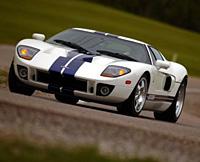First Production Ford GT Accelerates into the Future
 |
 |
By: Gary Hoffman | Ford Communications Network
DEARBORN, July 8, 2004 -- The first production 2005 Ford GT has arrived from the Wixom, Michigan Assembly Plant, bringing unprecedented speed, acceleration and horsepower to the performance-oriented buyer. The much-awaited vehicle -- often called the pace car for an entire company -- also is leading the way in manufacturing and design processes, pioneering rapid development cycles and uses of aluminum that could prove useful for other Ford vehicles.
The Ford GT’s on-track performance speaks for itself. The Ford GT can hit 205 miles per hour and generate 550 horsepower. With that kind of power, the Ford GT is able to go from zero to 60 miles per hour in 3.3 seconds and does the quarter mile in 11.6 seconds, reaching 128 miles per hour in that time.
In product development, the Ford GT’s performance has been just as impressive. The Ford GT team has pioneered virtual design and engineering methods that have made it possible to take the vehicle from concept to reality in a year. The result is a true production vehicle with legendary GT power.
The project has its modern origins in a Ford GT concept car exhibited in January, 2002. Shortly thereafter the green-light came for the development of a production super car that the performance enthusiast could handle and enjoy.
The vehicle also was to have the same exterior styling as the legendary Ford GTs of the 1960s and the 2002 concept car. It was also would be propelled by an engine comparable to the 7.0-liter engine that won the 24 hours at Le Mans in 1966 and 1967. (Thanks to engineering advances, the team would achieve this with 1.6 fewer liters of displacement, in the form of a 5.4 liter DOHC supercharged V8, produced at Romeo Engine Plant.)
The new vehicle would also be a virtually all-aluminum car on an aluminum frame, no small challenge for welding, riveting and adhesives technology.
Then, finally, there was the deadline. The production Ford GT would have to be delivered in time for the Ford Centennial in the summer of 2003.
2005 Ford GT “We had to design all the parts of the car, we had to get all the suppliers lined up, we had to tool the parts, and we had to assemble the car in time for the Ford Centennial,” said Bill Clarke, the program’s body engineering supervisor. “In just 12 months. We had to do a lot of things differently to achieve that goal.”
The Ford GT team beat that deadline. But to do so, it had to recruit top engineering talent and turn to advanced new processes.
Team members say it would have been impossible to take a production vehicle from concept to production in a year without resorting to the greater use of virtual design and engineering. The normal practices would have simply been too slow. Fred Goodnow, vehicle design engineering manager, estimates that the team employed 25 varieties of simulation and virtual reality software to do the work.
“We had to take the styling car that was such a huge hit at the January 2002 North American International Auto Show and put that car into production. That car was 5 percent feasible,” Goodnow said. “It was a styling model. It was a huge challenge to get everything into that car in that environment.”
One of the most important advantages was that virtual methods slashed the need for prototypes. Simulations were used for initial crash test modeling and for proving out chassis and body components. The project would eventually produce about 25 prototypes for its purposes instead of about 250. Best of all, the team found that its simulations proved highly accurate.
“The correlations between the computer predictions on all the different fronts and on the real prototypes was unbelievable,” Goodnow said. “That itself was one of the biggest things we can cascade from this program.”
The approach helped the team deal with the challenge of keeping the Ford GT’s traditional exterior while placing new technology under the skin. While new vehicles are normally developed from the inside out, the new GT was designed from the outside in. The outside recalled a racing legend from nearly a century ago. The inside would have to be state of the art.
“We learned a lot doing a car in a virtual world,” Goodnow said. “We could put a person in a car, any person in a car, and we could simulate if that person was male or female, big stature or small stature, and then see them reach into the tough zones. That was brand-new. We can reach out to other programs as result of doing all that virtual engineering.”
Goodnow said another advantage of the Ford GT program has to do with people, not just processes. The program brought some of Ford’s best engineers into the two-year program, he said, and performance automobiles are their passion.
“Everybody on the engineering team is a gear head, if you will,” he said. “They race motorcycles, they restore cars, they race cars, they build show cars, they have done it all. This was a dream come true because they get to do the same thing during the day they are doing on weekends,”
Now they will be heading out back into mainstream projects with a wealth of knowledge.
“These engineers learned in two years what would normally take 20 years,” Goodnow said. “They had to learn a lot more than they would in a mainstream program.”
“The bonus was that we got a GT out of it,” he added. “This car will be launched best in class. It is superior in everyway, and the car magazines have born that out. But the benefit to the company is phenomenal, because of the processes that we use, and some of the tools that we used to get here.”


